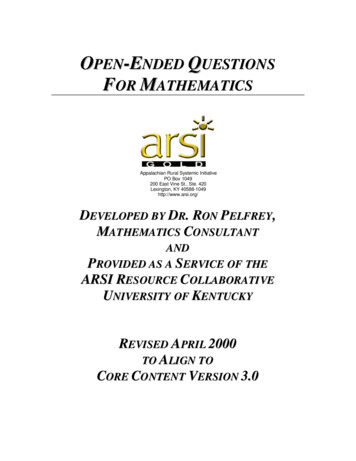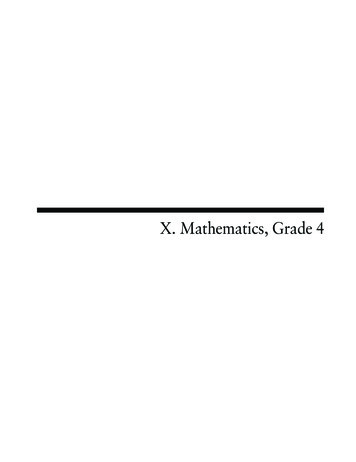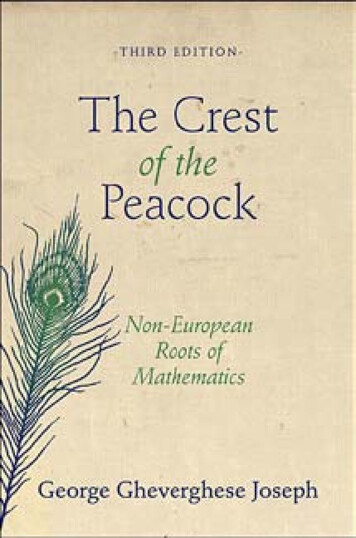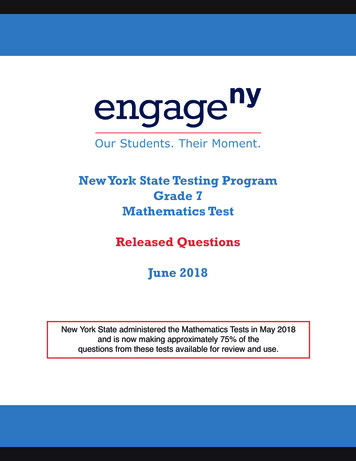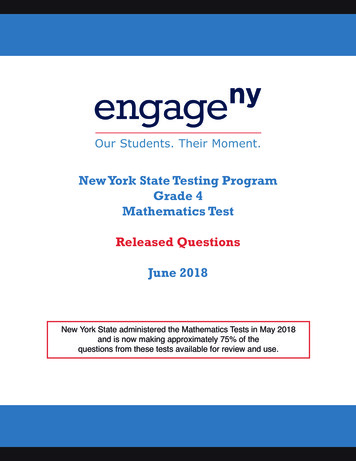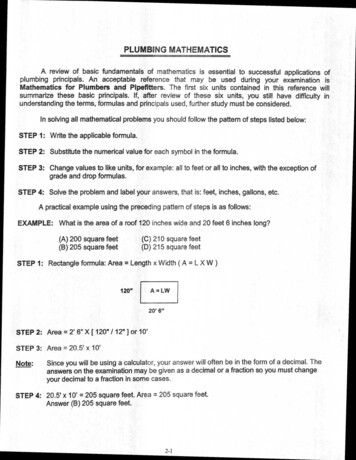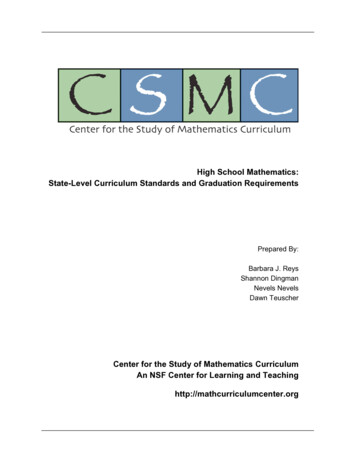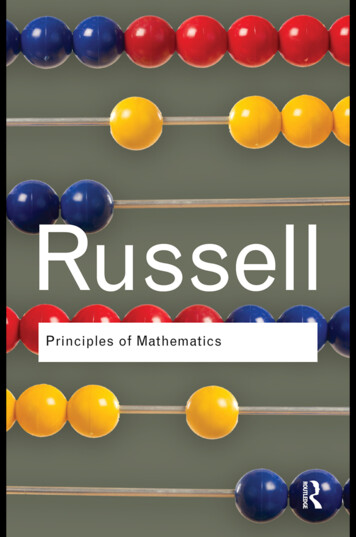
Transcription
Principles of Mathemat ics“Unless we are very much mistaken, its lucid application and development of the great discoveries of Peano and Cantor mark the opening ofa new epoch in both philosophical and mathematical thought”– The Spectator
BertrandRussellPrinciples of MathematicsLondon and New York
First published in 1903First published in the Routledge Classics in 2010by Routledge2 Park Square, Milton Park, Abingdon, Oxon OX14 4RNRoutledge is an imprint of the Taylor & Francis Group, an informa businessThis edition published in the Taylor & Francis e-Library, 2009.To purchase your own copy of this or any of Taylor & Francis or Routledge’scollection of thousands of eBooks please go to www.eBookstore.tandf.co.uk. 2010 The Bertrand Russell Peace Foundation LtdIntroduction 1992 John G. SlaterAll rights reserved. No part of this book may be reprintedor reproduced or utilized in any form or by any electronic,mechanical, or other means, now known or hereafterinvented, including photocopying and recording, or inany information storage or retrieval system, withoutpermission in writing from the publishers.British Library Cataloguing in Publication DataA catalogue record for this book is available from the British LibraryLibrary of Congress Cataloging in Publication DataA catalog record for this book has been requestedISBN 0-203-86476-X Master e-book ISBNISBN 10: 0-415-48741-2ISBN 10: 0-203-86476-X (ebk)ISBN 13: 978-0-415-48741-2ISBN 13: 978-0-203-86476-0 (ebk)
C ONTENTSintroduction to the 1992 editionintroduction to the second editionprefacePART I THE INDEFINABLES OF MATHEMATICS12Definition of Pure Mathematics1. Definition of pure mathematics2. The principles of mathematics are no longercontroversial3. Pure mathematics uses only a few notions,and these are logical constants4. All pure mathematics follows formally fromtwenty premisses5. Asserts formal implications6. And employs variables7. Which may have any value without exception8. Mathematics deals with types of relations9. Applied mathematics is defined by theoccurrence of constants which are not logical10. Relation of mathematics to logicSymbolic Logic11. Definition and scope of symbolic logic12. The indefinables of symbolic logic13. Symbolic logic consists of three partsxxvxxxixliii13334456678810101112
vicontentsA. The Propositional Calculus14.15.DefinitionDistinction between implication and formalimplication16. Implication indefinable17. Two indefinables and ten primitivepropositions in this calculus18. The ten primitive propositions19. Disjunction and negation 34.35.36.313131414151617B. The Calculus of Classes18Three new indefinablesThe relation of an individual to its classPropositional functionsThe notion of such thatTwo new primitive propositionsRelation to propositional calculusIdentity18191920202123C. The Calculus of Relations23The logic of relations essential to mathematicsNew primitive propositionsRelative productsRelations with assigned domains23242526D. Peano’s Symbolic Logic27Mathematical and philosophical definitionsPeano’s indefinablesElementary definitionsPeano’s primitive propositionsNegation and disjunctionExistence and the null-class272728303132Implication and Formal Implication37. Meaning of implication38. Asserted and unasserted propositions39. Inference does not require two premisses40. Formal implication is to be interpretedextensionally3434353737
contents41.42.43.44.45.456The variable in a formal implication has anunrestricted fieldA formal implication is a singlepropositional function, not a relation of twoAssertionsConditions that a term in an implicationmay be variedFormal implication involved in rulesof inferenceProper Names, Adjectives and Verbs46. Proper names, adjectives and verbsdistinguished47. Terms48. Things and concepts49. Concepts as such and as terms50. Conceptual diversity51. Meaning and the subject-predicate logic52. Verbs and truth53. All verbs, except perhaps is, express relations54. Relations per se and relating relations55. Relations are not particularized by their termsDenoting56. Definition of denoting57. Connection with subject-predicatepropositions58. Denoting concepts obtained from predicates59. Extensional account of all, every, any, a and some60. Intensional account of the same61. Illustrations62. The difference between all, every, etc. lies inthe objects denoted, not in the way ofdenoting them63. The notion of the and definition64. The notion of the and identity65. SummaryClasses66. Combination of intensional and extensionalstandpoints required67. Meaning of class68. Intensional and extensional genesis of 06364656667676868vii
viii ctions overlooked by PeanoThe class as one and as manyThe notion of andAll men is not analysable into all and menThere are null class-concepts, but there isno null-classThe class as one, except when it has oneterm, is distinct from the class as manyEvery, any, a and some each denote oneobject, but an ambiguous oneThe relation of a term to its classThe relation of inclusion between classesThe contradictionSummaryPropositional Functions80. Indefinability of such that81. Where a fixed relation to a fixed term isasserted, a propositional function can be analysedinto a variable subject and a constant assertion82. But this analysis is impossible in other cases83. Variation of the concept in a proposition84. Relation of propositional functions to classes85. A propositional function is in general notanalysable into a constant and a variable element696970737477777879808182828384868888The Variable86. Nature of the variable87. Relation of the variable to any88. Formal and restricted variables89. Formal implication presupposes any90. Duality of any and some91. The class-concept propositional function isindefinable92. Other classes can be defined by means ofsuch that93. Analysis of the variable898989919192Relations94. Characteristics of relations95. Relations of terms to themselves96. The domain and the converse domain of arelation95959693939397
contents97. Logical sum, logical product and relativeproduct of relations98. A relation is not a class of couples99. Relations of a relation to its terms10The Contradiction100. Consequences of the contradiction101. Various statements of the contradiction102. An analogous generalized argument103. Variable propositional functions are ingeneral inadmissible104. The contradiction arises from treating asone a class which is only many105. Other primâ facie possible solutions appearinadequate106. Summary of Part I989999101101102102103104105106PART II NUMBER10911Definition of Cardinal Numbers107. Plan of Part II108. Mathematical meaning of definition109. Definition of numbers by abstraction110. Objections to this definition111. Nominal definition of numbers11111111111211411512Addition and Multiplication112. Only integers to be considered at present113. Definition of arithmetical addition114. Dependence upon the logical addition of classes115. Definition of multiplication116. Connection of addition, multiplication andexponentiation118118118119120Finite and Infinite117. Definition of finite and infinite118. Definition of α0119. Definition of finite numbers bymathematical induction1221221231314Theory of Finite Numbers120. Peano’s indefinables and primitivepropositions121. Mutual independence of the latter121124125125126ix
xcontents122. Peano really defines progressions, not finitenumbers123. Proof of Peano’s primitive propositions15126128Addition of Terms and Addition of Classes124. Philosophy and mathematics distinguished125. Is there a more fundamental sense ofnumber than that defined above?126. Numbers must be classes127. Numbers apply to classes as many128. One is to be asserted, not of terms, but ofunit classes129. Counting not fundamental in arithmetic130. Numerical conjunction and plurality131. Addition of terms generates classesprimarily, not numbers132. A term is indefinable, but not the number 1130130Whole and Part133. Single terms may be either simple or complex134. Whole and part cannot be defined bylogical priority135. Three kinds of relation of whole and partdistinguished136. Two kinds of wholes distinguished137. A whole is distinct from the numericalconjunction of its parts138. How far analysis is falsification139. A class as one is an aggregate13813814214214317Infinite Wholes140. Infinite aggregates must be admitted141. Infinite unities, if there are any, are unknown to us142. Are all infinite wholes aggregates of terms?143. Grounds in favour of this view14414414514714718Ratios and Fractions144. Definition of ratio145. Ratios are one-one relations146. Fractions are concerned with relations ofwhole and part147. Fractions depend, not upon number, butupon magnitude of divisibility148. Summary of Part 52153
contentsPART III QUANTITY15519157202122The Meaning of Magnitude149. Previous views on the relation of numberand quantity150. Quantity not fundamental in mathematics151. Meaning of magnitude and quantity152. Three possible theories of equality to beexamined153. Equality is not identity of number of parts154. Equality is not an unanalysable relation ofquantities155. Equality is sameness of magnitude156. Every particular magnitude is simple157. The principle of abstraction158. SummaryNote157158159159160162164164166167168The Range of Quantity159. Divisibility does not belong to all quantities160. Distance161. Differential coefficients162. A magnitude is never divisible, but may be amagnitude of divisibility163. Every magnitude is unanalysable170170171173Numbers as Expressing Magnitudes: Measurement164. Definition of measurement165. Possible grounds for holding all magnitudesto be measurable166. Intrinsic measurability167. Of divisibilities168. And of distances169. Measure of distance and measure of stretch170. Distance-theories and stretch-theories ofgeometry171. Extensive and intensive magnitudes176176177178178180181Zero172. Difficulties as to zero173. Meinong’s theory174. Zero as minimum175. Zero distance as identity176. Zero as a null segment184184184185186186173174181182xi
xiicontents23177. Zero and negation178. Every kind of zero magnitude is in a senseindefinable187Infinity, the Infinitesimal and Continuity179. Problems of infinity not specially quantitative180. Statement of the problem in regard to quantity181. Three antinomies182. Of which the antitheses depend upon anaxiom of finitude183. And the use of mathematical induction184. Which are both to be rejected185. Provisional sense of continuity186. Summary of Part III189189189190187191193193194195PART IV ORDER19924The Genesis of Series187. Importance of order188. Between and separation of couples189. Generation of order by one-one relations190. By transitive asymmetrical relations191. By distances192. By triangular relations193. By relations between asymmetrical relations194. And by separation of couples20120120120220520620620720725The Meaning of Order195. What is order?196. Three theories of between197. First theory198. A relation is not between its terms199. Second theory of between200. There appear to be ultimate triangularrelations201. Reasons for rejecting the second theory202. Third theory of between to be rejected203. Meaning of separation of couples204. Reduction to transitive asymmetrical relations205. This reduction is formal206. But is the reason why separation leads toorder209209209210212213214215215216217218218
contents207. The second way of generating series is alonefundamental, and gives the meaning of order26272829218Asymmetrical Relations208. Classification of relations as regardssymmetry and transitiveness209. Symmetrical transitive relations210. Reflexiveness and the principle ofabstraction211. Relative position212. Are relations reducible to predications?213. Monadistic theory of relations214. Reasons for rejecting this theory215. Monistic theory and the reasons forrejecting it216. Order requires that relations should beultimate220Difference of Sense and Difference of Sign217. Kant on difference of sense218. Meaning of difference of sense219. Difference of sign220. In the cases of finite numbers221. And of magnitudes222. Right and left223. Difference of sign arises from difference ofsense among transitive asymmetrical relations229229230230231231233On the Difference Between Open and Closed Series224. What is the difference between open andclosed series?225. Finite closed series226. Series generated by triangular relations227. Four-term relations228. Closed series are such as have an arbitraryfirst term236Progressions and Ordinal Numbers229. Definition of progressions230. All finite arithmetic applies to everyprogression231. Definition of ordinal numbers232. Definition of “nth”233. Positive and negative 240241241242244245246xiii
xiv contents30Dedekind’s Theory of Number234. Dedekind’s principal ideas235. Representation of a system236. The notion of a chain237. The chain of an element238. Generalized form of mathematical induction239. Definition of a singly infinite system240. Definition of cardinals241. Dedekind’s proof of mathematical induction242. Objections to his definition of ordinals243. And of ce244. Distance not essential to order245. Definition of distance246. Measurement of distances247. In most series, the existence of distances isdoubtful248. Summary of Part IV254254255256256257PART V INFINITY AND CONTINUITY2593226133The Correlation of Series249. The infinitesimal and space are no longerrequired in a statement of principles250. The supposed contradictions of infinity havebeen resolved251. Correlation of series252. Independent series and series by correlation253. Likeness of relations254. Functions255. Functions of a variable whose values form aseries256. Functions which are defined by formulae257. Complete seriesReal Numbers258. Real numbers are not limits of series ofrationals259. Segments of rationals260. Properties of segments261. Coherent classes in a 76276
contents34353637Limits and Irrational Numbers262. Definition of a limit263. Elementary properties of limits264. An arithmetical theory of irrationals isindispensable265. Dedekind’s theory of irrationals266. Defects in Dedekind’s axiom ofcontinuity267. Objections to his theory of irrationals268. Weierstrass’s theory269. Cantor’s theory270. Real numbers are segments of rationals278278279280281281282284285288Cantor’s First Definition of Continuity271. The arithmetical theory of continuity is dueto Cantor272. Cohesion273. Perfection274. Defect in Cantor’s definition of perfection275. The existence of limits must not beassumed without special grounds290Ordinal Continuity276. Continuity is a purely ordinal notion277. Cantor’s ordinal definition of continuity278. Only ordinal notions occur in thisdefinition279. Infinite classes of integers can be arrangedin a continuous series280. Segments of general compact series281. Segments defined by fundamental series282. Two compact series may be combined toform a series which is not compact299299299Transfinite Cardinals283. Transfinite cardinals differ widely fromtransfinite ordinals284. Definition of cardinals285. Properties of cardinals286. Addition, multiplication and exponentiation287. The smallest transfinite cardinal α0288. Other transfinite cardinals289. Finite and transfinite cardinals form a singleseries by relation to greater and 12314314xv
xvi contents38394041Transfinite Ordinals290. Ordinals are classes of serial relations291. Cantor’s definition of the second class of ordinals292. Definition of ω293. An infinite class can be arranged in manytypes of series294. Addition and subtraction of ordinals295. Multiplication and division296. Well-ordered series297. Series which are not well-ordered298. Ordinal numbers are types of well-orderedseries299. Relation-arithmetic300. Proofs of existence-theorems301. There is no maximum ordinal number302. Successive derivatives of a e Infinitesimal Calculus303. The infinitesimal has been usually supposedessential to the calculus304. Definition of a continuous function305. Definition of the derivative of a function306. The infinitesimal is not implied in thisdefinition307. Definition of the definite integral308. Neither the infinite nor the infinitesimal isinvolved in this definition330The Infinitesimal and the Improper Infinite309. A precise definition of the infinitesimal isseldom given310. Definition of the infinitesimal and theimproper infinite311. Instances of the infinitesimal312. No infinitesimal segments in compact series313. Orders of infinity and infinitesimality314. Summary336Philosophical Arguments Concerning the Infinitesimal315. Current philosophical opinions illustratedby Cohen316. Who bases the calculus upon infinitesimals317. Space and motion are here 43343344
contents318. Cohen regards the doctrine of limits asinsufficient for the calculus319. And supposes limits to be essentiallyquantitative320. To involve infinitesimal differences321. And to introduce a new meaning of equality322. He identifies the inextensive with the intensive323. Consecutive numbers are supposed to berequired for continuous change324. Cohen’s views are to be rejected4243The Philosophy of the Continuum325. Philosophical sense of continuity nothere in question326. The continuum is composed of mutuallyexternal units327. Zeno and Weierstrass328. The argument of dichotomy329. The objectionable and the innocent kind ofendless regress330. Extensional and intensional definitionof a whole331. Achilles and the tortoise332. The arrow333. Change does not involve a state of change334. The argument of the measure335. Summary of Cantor’s doctrine of continuity336. The continuum consists of elementsThe Philosophy of the Infinite337. Historical retrospect338. Positive doctrine of the infinite339. Proof that there are infinite classes340. The paradox of Tristram Shandy341. A whole and a part may be similar342. Whole and part and formal implication343. No immediate predecessor of ω or α0344. Difficulty as regards the number of all terms,objects or propositions345. Cantor’s first proof that there is nogreatest number346. His second proof347. Every class has more sub-classes than 1xvii
xviii contents348. But this is impossible in certain cases349. Resulting contradictions350. Summary of Part V372372373PART VI SPACE375443773774546Dimensions and Complex Numbers351. Retrospect352. Geometry is the science of series of two ormore dimensions353. Non-Euclidean geometry354. Definition of dimensions355. Remarks on the definition356. The definition of dimensions is purely logical357. Complex numbers and universal algebra358. Algebraical generalization of number359. Definition of complex numbers360. Remarks on the definitionProjective Geometry361. Recent threefold scrutiny of geometricalprinciples362. Projective, descriptive and metrical geometry363. Projective points and straight lines364. Definition of the plane365. Harmonic ranges366. Involutions367. Projective generation of order368. Möbius nets369. Projective order presupposed in assigningirrational coordinates370. Anharmonic ratio371. Assignment of coordinates to anypoint in space372. Comparison of projective and Euclideangeometry373. The principle of dualityDescriptive Geometry374. Distinction between projective anddescriptive geometry375. Method of Pasch and Peano376. Method employing serial 0390391392394395396396397398399399400401
contents377. Mutual independence of axioms378. Logical definition of the class of descriptivespaces379. Parts of straight lines380. Definition of the plane381. Solid geometry382. Descriptive geometry applies to Euclideanand hyperbolic, but not elliptic space383. Ideal elements384. Ideal points385. Ideal lines386. Ideal planes387. The removal of a suitable selection of pointsrenders a projective space descriptive4748Metrical Geometry388. Metrical geometry presupposes projectiveor descriptive geometry389. Errors in Euclid390. Superposition is not a valid method391. Errors in Euclid (continued)392. Axioms of distance393. Stretches394. Order as resulting from distance alone395. Geometries which derive the straight linefrom distance396. In most spaces, magnitude of divisibility canbe used instead of distance397. Meaning of magnitude of divisibility398. Difficulty of making distance independent ofstretch399. Theoretical meaning of measurement400. Definition of angle401. Axioms concerning angles402. An angle is a stretch of rays, not a classof points403. Areas and volumes404. Right and leftRelation of Metrical to Projective and DescriptiveGeometry405. Non-quantitative geometry has no 1422423423425425xix
xxcontents406. Historical development of non-quantitativegeometry407. Non-quantitative theory of distance408. In descriptive geometry409. And in projective geometry410. Geometrical theory of imaginary point-pairs411. New projective theory of distance49505152Definitions of Various Spaces412. All kinds of spaces are definable in purelylogical terms413. Definition of projective spaces of threedimensions414. Definition of Euclidean spaces of threedimensions415. Definition of Clifford’s spaces of twodimensionsThe Continuity of Space416. The continuity of a projective space417. The continuity of a metrical space418. An axiom of continuity enables us todispense with the postulate of the circle419. Is space prior to points?420. Empirical premisses and induction421. There is no reason to desire our premissesto be self-evident422. Space is an aggregate of points, not a unityLogical Arguments Against Points423. Absolute and relative position424. Lotze’s arguments against absolute position425. Lotze’s theory of relations426. The subject-predicate theory of propositions427. Lotze’s three kinds of being428. Argument from the identity of indiscernibles429. Points are not active430. Argument from the necessary truths ofgeometry431. Points do not imply one anotherKant’s Theory of Space432. The present work is diametrically opposedto 46447447448451451452452454455457458460460462462
contents433. Summary of Kant’s theory434. Mathematical reasoning requires no extralogical element435. Kant’s mathematical antinomies436. Summary of Part VI462463464467PART VII MATTER AND MOTION46953471Matter437. Dynamics is here considered as a branch ofpure mathematics438. Matter is not implied by space439. Matter as substance440. Relations of matter to space and time441. Definition of matter in terms of logicalconstants47454Motion442. Definition of change443. There is no such thing as a state of change444. Change involves existence445. Occupation of a place at a time446. Definition of motion447. There is no state of motion47647647847847947948055Causality448. The descriptive theory of dynamics449. Causation of particulars by particulars450. Cause and effect are not temporally contiguous451. Is there any causation of particulars byparticulars?452. Generalized form of causality48148148248448448556Definition of a Dynamical World453. Kinematical motions454. Kinetic motions48748748757Newton’s Laws of Motion455. Force and acceleration are fictions456. The law of inertia457. The second law of motion458. The third law459. Summary of Newtonian principles460. Causality in dynamics489489489490490492493471471472473xxi
xxii contents461. Accelerations as caused by particulars462. No part of the laws of motion is an à priori truth49449658Absolute and Relative Motion463. Newton and his critics464. Grounds for absolute motion465. Neumann’s theory466. Streintz’s theory467. Mr Macaulay’s theory468. Absolute rotation is still a change of relation469. Mach’s reply to Newton49749749849949949950050059Hertz’s Dynamics470. Summary of Hertz’s system471. Hertz’s innovations are not fundamentalfrom the point of view of pure mathematics472. Principles common to Hertz and Newton473. Principle of the equality of cause and effect474. Summary of the work502502503504504505APPENDICES507List of Abbreviations508APPENDIX A509The Logical and Arithmetical Doctrines of Frege475. Principal points in Frege’s doctrines476. Meaning and indication477. Truth-values and judgment478. Criticism479. Are assumptions proper names for the trueor the false?480. Functions481. Begriff and Gegenstand482. Recapitulation of theory of propositionalfunctions483. Can concepts be made logical subjects?484. Ranges485. Definition of ε and of relation486. Reasons for an extensional view of classes487. A class which has only one member isdistinct from its only member488. Possible theories to account for this fact509509510511512513513515516519520521522523523
contents489. Recapitulation of theories already discussed490. The subject of a proposition may be plural491. Classes having only one member492. Theory of types493. Implication and symbolic logic494. Definition of cardinal numbers495. Frege’s theory of series496. Kerry’s criticisms of Frege525526527528529529530530APPENDIX B534The Doctrine of Types497. Statement of the doctrine498. Numbers and propositions as types499. Are propositional concepts individuals?500. Contradiction arising from the questionwhether there are more classes of propositions thanpropositions534534537537index541538xxiii
I NTRODUCTIONTO THE1992 E DITIONThe Principles of Mathematics, Russell’s fourth book, was first published in 1903; itwas reprinted unchanged in 1937 with a new introduction. The originaledition was the first member in one of two series of books that Russellproposed to write during his lifetime. In the first volume of his Autobiography(1967), covering the years 1872 to 1914, he recollected one of the mostimportant days of his life: “I remember a cold bright day in early springwhen I walked by myself in the Tiergarten, and made projects of future work.I thought that I would write one series of books on the philosophy of thesciences from pure mathematics to physiology, and another series of bookson social questions. I hoped that the two series might ultimately meet in asynthesis at once scientific and practical. My scheme was largely inspired byHegelian ideas. Nevertheless, I have to some extent followed it in later years,as much at any rate as could have been expected. The moment was animportant and formative one as regards my purposes.” The year was 1895,and the city was Berlin, where Russell and his first wife had gone to studyGerman social democracy. In other writings Russell added that the first seriesof books would begin at a very high level of abstraction and graduallygrow more practical, whereas the second set would begin with practicalmatters and aim at becoming always more abstract; the final volume in eachseries would then be a similar blend of the practical and the abstract, and thuspermit a grand synthesis of the two series in one magnum opus.Russell was not yet 23 when this vision occurred to him, but, as is clearfrom the above quotation, the initial planning of The Principles of Mathematicshad already begun. At other places in his writings he states that his interest inthe foundations of mathematics stemmed from an earlier interest in thefoundations of physics, or “the problem of matter” as he usually referred to
xxvi introduction to the 1992 editionit, which was stymied when he realized the dependence of physics on asoundly based mathematics. His preliminary examination of the problem ofmatter must then have occurred at about the same time as the Tiergartenexperience. By 1895 he already had two books in the works: the first, GermanSocial Democracy (1896), reported the results of his Berlin studies; the second,An Essay on the Foundations of Geometry (1897), was his dissertation for a Fellowship at Trinity College, Cambridge. On the strength of it he was elected aFellow on 10 October 1895. For book publication it had to be revised, whichaccounts for the delay of two years. While he was revising it he began workon Principles.There exist in the Bertrand Russell Archives, housed at McMaster Universityin Hamilton, Ontario, Canada, a large number of manuscripts documentingin part his slow progress toward a final version of Principles. The earlier papershave now been published in Volume 2 of The Collected Papers of Bertrand Russell(1990), edited by Nicholas Griffin and Albert C. Lewis; the remaining oneswill be published in Volume 3, edited by Greg Moore, which is nearly readyfor publication. Russell entitled the earliest manuscript, which survives onlyin part, “An Analysis of Mathematical Reasoning, Being an Inquiry into theSubject-Matter, the Fundamental Conceptions, and the Necessary Postulatesof Mathematics”. Begun after 1 April 1898, it was finished some time in Julyof that year. Griffin notes that it was written when Russell was very muchunder the influence of Alfred North Whitehead’s first book, A Treatise onUniversal Algebra with Applications (1898). Whitehead had been one of Russell’steachers at Cambridge, and later agreed to collaborate with him in completing his work on the foundations of mathematics. This early draft, like hisFellowship dissertation, displays a strong Kantian influence. Russell discussedthis draft at various times with both G. E. Moore and Whitehead; Mooreappears, from the evidence available, to have been more critical of it thanWhitehead. We do not know why Russell abandoned this attempt. Some partsof it were incorporated in later versions, but large parts of it remainuntouched.His next attempt wa
3. Pure mathematics uses only a few notions, and these are logical constants 4 4. All pure mathematics follows formally from twenty premisses 4 5. Asserts formal implications 5 6. And employs variables 6 7. Which may have any value without exception 6 8. Mathematics deals with types of relations 7



